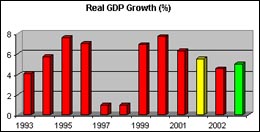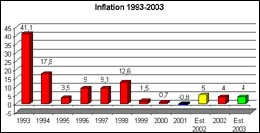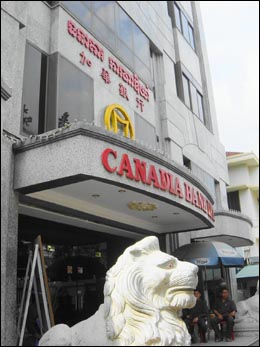 Economy
and Finance Economy
and Finance |
In the year 2002, the economic situation of Cambodia
reflected the challenges that the Royal Government
of Cambodia had to face: political uncertainty,
Iraqi war and the severe drought and flood that
affected agricultural production, especially rice
and other crops, which account for 15% of GDP.
 Macroeconomic
developments Macroeconomic
developments |
In order to ensure economic growth as forecasted,
the RGC launched measures to mitigate the effect
of the drought and it accelerated the mobilization
of local resources and those from bilateral donors
and international financial institutions to continue
the reforms and to accelerate economic and social
development in Cambodia.
The RGC has continued to develop the implementation
of its economic reform program by realizing a
low inflation and stable economic growth. The
RGC has forecasted that the GDP would increase
5% in 2002, compared to 5.5% projected earlier,
due to the impact of the drought and flood on
agriculture and slower increase in the production
and exports of garment, and the negative effects
of the SARS disease.

The main pillars of growth in 2002 were industry
and service sector. Manufacturing and construction
have been the main drive to sustain growth in
the industrial sector. Garment exports increased
by 22 percent to US$1.3 billion.
The government has pursued "the Locomotive
Strategy" to support development by establishing
a nation-wide road network linking various provinces
to Phnom Penh, the Sihanoukville port and important
border checkpoints; as the Minister
of Finance, H.E. Keat Chhon said: "(…)
we put a strong emphasis on the construction our
infrastructure, particularly the roads. This was
done because opening the country and ease the
flow of goods was the priority in out National
Strategy for Poverty Reduction". This will
create the integration of different parts of Cambodia
into a single market.
This strategy will help reduce transportation
costs and facilitate trade. Infrastructure (road
and bridge) construction financed by concessional
loans from Japan, ADB, WB, other donors and government
budget was on the rise in 2002. The Kizuna Bridge
was inaugurated.
By the end of the 4th quarter of 2002 the inflation
was 3.7% due to the government's continued prudent
budget and monetary policy. The exchange rate
RIEL-USD was broadly stable, around 3.950 Riels.

The current account deficit, excluding transfer,
was -9.4% in 2001 and increased to-9.6% in 2002.
At year-end, the reserve in the banking system
increased from 551 million USD in 2001 to 629
million USD in 2002 covering 3.4 months of imports.
 Medium
Term Fiscal Framework Medium
Term Fiscal Framework |
Achieving macroeconomic stability with high economic
growth of 6-7 percent as stated earlier would
require serious actions in implementing the reform
programs and supporting policies. This includes
no monetarization of fiscal deficit, sound financial
system oversight, deepening banking reform, improvements
in revenue, spending increase for social and economic
sector, sound budget and treasury management,
improving investment climate, civil service reform,
legal and judicial reforms.
To this end, actions have been taken to strengthen
tax policy and administration in order to (i)
increase tax revenue, (ii) improve design of the
tax system, (iii) enhance capacity for tax analysis,
(iv) improve administration of the real regime,
(v) improve administration of the estimated regime,
and (vi) expand training and learning in tax administration.
Taxes, defined as taxes as percent of GDP, is
expected to increase from 8.5 percent in 2002
to 8.8 percent by 2005 while non-tax revenue effort
will remain around 3.5 percent from 2002 to 2005.
Overall fiscal revenue as percent of GDP will
grow steadily though slowly from 12.1 percent
in 2002 to 13.9 percent in 2005. It is assumed
that the significant increase in fiscal revenues
in absolute terms will be driven mainly by high
and sustained growth of the Cambodian economy
and implementing reform measures rather than a
dramatic improvement in revenue effort.
As percent of GDP, total expenditure is expected
to increase moderately - from 18.9 percent in
2002 to 19.4 percent in 2005. The planned level
of capital expenditures shows the commitment of
the RGC to invest in physical infrastructure.
Capital expenditures will account for about 7.1-7.8
percent.
Within this frame a blue print for the development
of the financial
and banking sector has been put in place by
the Ministry
of Finance and Economy, this latter shows
the evolution expected of the sector until 2006.
 Dollarization Dollarization |
Dollarization emerged as a consequence of low
confidence and a persistent feeling of uncertainty
with regard to the national currency. Cambodia
is a highly but not a 'fully' dollarized economy.
The government, through the MEF still remains
the core institution that injects riel into circulation.
Dollarization has provided both benefits and drawbacks
for economic development and poverty reduction.
Partial dollarization has imposed some discipline
on fiscal operations, and the commitments of the
government to establish political and macroeconomic
stability were and remain a crucial factor for
a reform program to be a success. It is also in
this context that both the autonomy of the central
bank in carrying out its functions and the accompanying
accountability must be recognized.
There is limited room for fiscal adjustment because
dollarization puts constraint on the mechanism
of deficit financing other than external debt
or assistance or domestic borrowing at market-determined
interest rate. In other words, dollarization may
deprive fiscal benefit that can occur when the
government runs a fiscal deficit through the central
bank's expansion of money supply.
 Monetary
Developments Monetary
Developments |
The principal mission of the National Bank of
Cambodia (NBC) is to determine and direct the
monetary policy with the aim of maintaining price
stability in order to facilitate economic development
within the framework of the economic and development
policy. Prudent monetary policy and fiscal discipline
have been successful in achieving and maintaining
macroeconomic stability with low inflation (5%).
|
Since the end of 2000, claims on the government
by the banking sector have been virtually eliminated.
Credit from the central bank to the remainder
of the banking system remains absent. The NBC
has constantly accumulated its international reserves.
Growth in the country's gross international reserves
has kept pace with the continuous increase in
total imports of goods and services and reached
more than three months cover in recent years.
Inflation has been kept within the target and
in fact turned negative during recent period,
while the value of the riel has largely been stabilized.

Concerning the current state of the banking system,
the liquid asset ratio is close to 60%. However,
due to the fact that a large proportion of bank
assets are held in low yielding assets, the profitability
of the banking sector is low.
 The new
banking systems The new
banking systems |
As the Governor of NBC, H.E. Chea Chanto explained,
the main component of the Law on Banking and financial
institutions passed in 1999 "was the requirement
of a minimum capital (USD 13 million) to the banks
and the imposition to provide the legal basis
for supervision". Before the re-licensing,
there were more than 30 commercial banks. Presently,
there are thus only 17, operating in the country
from which two are state-owned.
One of them, the Canadia
Bank Ltd, founded by Pung Kheav Se, has in
deposits 26% of the whole country's desposits
and its loans are about 32% of country's total.
It is also the first commercial bank in Cambodia
to use the smart card system and it was chosen
by the Ministry
of Economy and Finance to run a small and
medium enterprise project with KfW, a German financial
institution. Actually, as the President of Canadia
Bank, Pung
Kheav Se underlined "The problem you
encounter in Cambodia is that if you deposit 1
million, 48% to 52% of it must remain in the bank...
So, our target is to find foreign financial institutions
to have long-term local funds for economic development"
and he added that the loan interest now is 12%
and "This is very hard for local businessmen,
we have to reduce the interest rate".

There is also an Association of banks in Cambodia,
which currently has 23 members, consisting of
local and foreign banks. "We began to organize
ourselves in 1994 and are now fully recognized
under the banking Act" explained its President,
Khov
Boun Chhay, who is also President and Chief
executive officer of the MekongBank.
The chief functions are to share information among
members, to participate in joint activities such
as training and to act as a single voice for the
industry in dealing with the public and the Royal
government. They are also members of the ASEAN
Bankers Association "which has been of great
benefit to individual banks and to the Cambodian
banking system as a whole".
MekongBank,
have also the ambition to become a leader in the
region and worldwide, and began to establish many
strategic partnership through the world, linking
thus the Cambodian Banking sector to many relevant
international actors, as its president Khov Boun
Chhay explains us; "We have established correspondent
relations with major international banks in Europe,
Asia and the United States. For example, through
our principle international correspondent and
strategic partner, ABN-AMRO Bank, we have access
to their global network of over 3,500 locations
in 76 countries. Another critical element in MekongBank's
international policy involves the establishment
of strategic alliances with key financial institutions
throughout the region."
An other major locally based bank, the SBC
(Singapore
Banking Corporation) (http://www.sbc-bank.com)
Bank, it is investing in a VISA credit card system
and as underlined his President, Andy Kun, "It's
going to be the first in Indochina and one of
the few in Southeast Asia to issue an EMV chip-based
credit card". All this initiatives mark clearly
the dynamism of the sector, which will be crucial
for the development of the local economy.
In order to implement the economical reconstruction
of the country, NBC and IMF have mainly a stabilization
program called Poverty reduction and growth facility,
involving around USD 84 million. With the Asian
Development Bank (ADB), NBC works closely on the
formulation of a long term plan development. The
ADB, which has also provided the technical assistance
to strengthen the micro finance supervision, the
AFD (Agence Française de développement)
collaborates in the field of strengthening micro-finance
institutions, especially providing the small credit
to farmers in the rural area.
The strengthening of the financial sector is
also a priority of the Minister
of Finance and Economy: "The financial
sector is of course of strategic importance (…)
This includes the development of our banking and
insurance system as well as our leasing, capital
markets and other financial products systems".
Concerning the creation of the Cambodian Stock
Exchange, NBC's board has set a list of priorities.
The first one is to strengthen the banking sector
to introduce a sound accounting system in the
whole country, but the Governor doesn't expect
the creation before 2008-2010.
|

